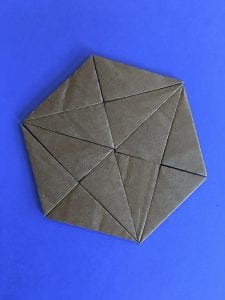 Start with a plain hexagon. Decorate it to make it beautiful. If you can, print it out on tag. When you are finished decorating it, glue it down onto craft foam before the next step: Hexagon-19c7cos
Start with a plain hexagon. Decorate it to make it beautiful. If you can, print it out on tag. When you are finished decorating it, glue it down onto craft foam before the next step: Hexagon-19c7cos
Cut it into 12 right angle triangles like this:
Too hard? I have a die cut for that. Now you’ve made a geometry tool we call Shape Shifters.
Next, learn how it transforms. There are many interesting shape challenges. Can you turn it into a triangle? A rectangle? A pentagon? An octagon? Can you make a star shape? How about a boat or a house or a fish?
What do you notice about your shapes? Do you notice parallel lines? Edges? Vertices? Angles? Use your geometry lens to interpret the shapes you have made. This can be done from kindergarten – grade 5.
Next, time to listen to a story. Don’t look at the pictures. Why? It is important to listen and to imagine. Plus, Aboriginal stories always used to be shared orally. So, listen to the story carefully. What are important story elements? Brainstorm together. Think of characters, elements of the setting or important objects.
Work with a buddy. An older buddy is really great. Use your shape shifters to create shapes that match those important story elements. Time to take a picture or go for a shape walk around the classroom. What did other groups create? Can you tell?
Next, time to use your geometry lens again. Write out what you notice about your shape. Think of everything you know about shapes. What do you see?
This is so much fun to play around with as is a very meaningful application of geometric skills.
